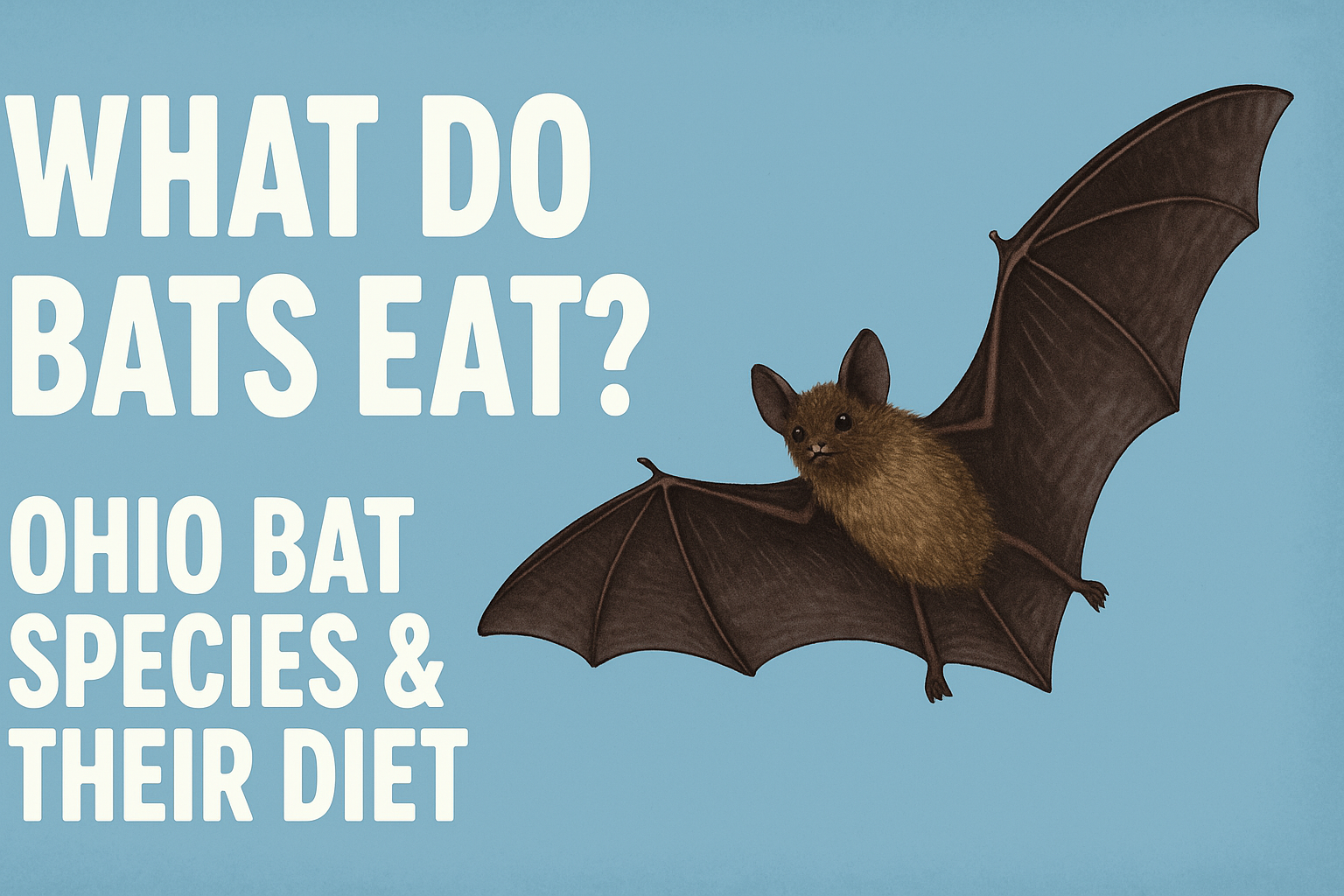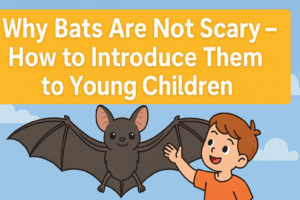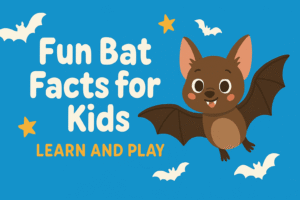Let’s settle a question that’s probably fluttered through your head at some point:
What do bats actually eat?
And no, they’re not out here slurping blood like vampire lore wants you to believe (except a few tropical species that do that—but not in Ohio, and not in your backyard, promise).
Here in the Buckeye State, bats are more into bugs than blood. They’re like flying exterminators—keeping the skies clearer and the mosquitoes fewer.
So whether you’re just curious, planning a bat-friendly garden, or trying to impress your friends at your next Ohio campfire, here’s your go-to guide on what bats in Ohio eat—species by species.
Ohio’s Bat Diet: The TL;DR
Ohio bats are all insectivores.
That means they eat insects—lots of them—and play a major role in controlling pest populations, both in cities and farmlands.
The average Ohio bat can eat 50–100% of its body weight in insects each night.
Let that sink in.
Ohio’s Most Common Bat Species & Their Favorite Foods
1. Little Brown Bat (Myotis lucifugus)
Diet style: Fast food junkie of the night sky
Eats:
- Mosquitoes
- Midges
- Caddisflies
- Beetles
- Moths
- Mayflies
Fun fact:
These guys love flying over ponds and rivers because water = insects = buffet. They’re fast and efficient, scooping up bugs on the wing like little aerial vacuums.
2. Big Brown Bat (Eptesicus fuscus)
Diet style: Crunchy protein lover
Eats:
- Beetles (especially crop-destroying types)
- Stink bugs
- Moths
- Flies
- True bugs
- Grasshoppers
Fun fact:
Their strong jaws let them tackle hard-bodied insects other bats might skip. They’re basically the muscle of Ohio’s bat world—chewing through tough beetle shells like it’s nothing.
3. Eastern Red Bat (Lasiurus borealis)
Diet style: Dusk-time insect chaser
Eats:
- Moths
- Beetles
- Leafhoppers
- Planthoppers
- Flies
Fun fact:
They feed mostly in open areas near trees, swooping out of their roosts around twilight and feeding in forest clearings or over grasslands. Think of them as the bat version of a drive-thru regular.
4. Hoary Bat (Lasiurus cinereus)
Diet style: The power flyer with a picky palate
Eats:
- Moths (like, tons of them)
- Beetles
- Grasshoppers
- Dragonflies
- Wasps
Fun fact:
Hoary bats are strong flyers and prefer to hunt above the treetops, where fewer bats go. They can travel long distances to find food—sometimes migrating across states to follow the bugs.
5. Tri-Colored Bat (Perimyotis subflavus)
Diet style: The early bird of bats
Eats:
- Moths
- Midges
- Flies
- Beetles
Fun fact:
They’re often the first bats to emerge at dusk, fluttering low along the forest edge and near water sources to snag small, soft-bodied insects before other bats clock in.
6. Silver-Haired Bat (Lasionycteris noctivagans)
Diet style: The stealth hunter
Eats:
- Moths
- Flies
- Beetles
- Leafhoppers
- Caddisflies
Fun fact:
Silver-haired bats are slower flyers compared to other species, which helps them sneak up on their prey in dense forests. They love moths and do most of their work over water or wooded areas.
Why Bat Diets Matter (for You, Me, and the Planet)
Let’s connect the dots real quick:
Bats eat bugs → bugs harm crops or bite humans → bats protect our food and sanity.
Here’s the bigger picture:
1. Bats Control Mosquitoes
Bats don’t just eat them—they crave them.
This helps reduce the spread of mosquito-borne diseases like:
- West Nile virus
- Zika
- Eastern Equine Encephalitis (EEE)
And they do it naturally—no pesticides required.
2. They Save Crops
Big brown bats, in particular, go after beetles and moths that devour corn, soybeans, and other crops.
Farmers benefit. You benefit (via lower food prices). The planet benefits (fewer chemicals).
Economic win:
A 2011 study estimated that U.S. agriculture saves $3.7 billion a year in pest control services thanks to bats.
That’s not just helpful—that’s huge.
3. They Keep Ecosystems Balanced
Without bats?
- Insects explode in number
- Food webs get messy
- More pressure gets placed on birds and other insect predators
Bats help maintain insect diversity and keep everything from your backyard to large forests in check.
Wait—Do Any Ohio Bats Eat Fruit or Nectar?
Nope. Not in Ohio.
All of Ohio’s native bats are insectivores.
The fruit- and nectar-eating bats (like flying foxes and leaf-nosed bats) live in tropical or subtropical regions like:
- Central & South America
- Southeast Asia
- Parts of Africa
So unless you’re importing exotic species (please don’t), your local bats are all about the bugs.
Bat Diet Myth Busting
Let’s clear up a few popular myths:
“All bats suck blood!”
Only 3 species worldwide drink blood. They live in Latin America. None live in the U.S. or Ohio. Relax.
“Bats eat all our fruit.”
Ohio bats aren’t fruit-eaters. They won’t raid your apple tree.
“Bats attack people.”
They don’t. They’re shy. They want bugs—not your face.
Want to Attract More Bug-Eating Bats?
Make your yard a bat buffet with these simple steps:
- Install a bat house — Give them a cozy roost
- Plant night-blooming flowers — Attract moths and night insects
- Avoid pesticides — So bats don’t ingest toxins from poisoned insects
- Add a water source — Insects love it, so bats follow
- Turn off bright lights at night — Too much light deters bats and their food
Check out my full guide on How to Make Your Backyard Bat-Friendly in Ohio if you want the nitty-gritty!
Final Thoughts: Bats Don’t Bug You—They Eat the Bugs That Do
Every night, Ohio’s bats clock in to a job they’ve been doing for millions of years:
devouring the bugs that bug us.
They don’t need tips, thanks, or a snack cart—just a little space to roost, a sky full of insects, and a place where humans don’t freak out every time one flies by.
So next time you’re outside enjoying a peaceful, bite-free summer evening, silently raise your glass to the bats flitting through the air above.
They’ve earned it.
Got questions about Ohio bat species or want help choosing plants that attract moths (and bats)? Drop a comment—I’m always down for bat chat.




